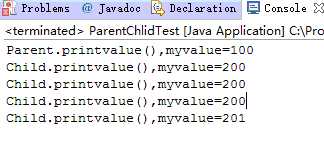标签:java demo 转化 out 手动 ++ 相同 log images
实验任务一:多态实现ATM工作原理
1)源代码:
package demo;
import java.util.Scanner;
class A{
String name;
String date;
String mima;
int yu;
String kahao;
public A(String name,String date,String mima,int yu,String kahao)
{
this.name=name;
this.date=date;
this.mima=mima;
this.yu=yu;
this.kahao=kahao;
}
public A(){}
public void way(){}
}
class Qukuan extends A{
public Qukuan(String str,String str1,String str2,int m,String str3){
name=str;
date=str1;
mima=str2;
yu=m;
kahao=str3;
}
public void way(){
System.out.println("100 200 1000 1500 2000 5000 1.其它金额 2. 退卡3.返回操作");
Scanner in=new Scanner(System.in);
int p=in.nextInt();
A a=new A(name,date,mima,yu,kahao);
if(p==100)
{
a.yu-=100;
System.out.println("取款成功,余额:"+a.yu);
}
else if(p==200)
{
a.yu-=200;
System.out.println("取款成功,余额:"+a.yu);
}
else if(p==500)
{
a.yu-=500;
System.out.println("取款成功,余额:"+a.yu);
}
else if(p==1000)
{
a.yu-=1000;
System.out.println("取款成功,余额:"+a.yu);
}
else if(p==1500)
{
a.yu-=1500;
System.out.println("取款成功,余额:"+a.yu);
}
else if(p==2000)
{
a.yu-=2000;
System.out.println("取款成功,余额:"+a.yu);
}
else if(p==5000)
{
a.yu-=5000;
System.out.println("取款成功,余额:"+a.yu);
}
else if(p==1)
{
System.out.println("请输入要取款的金额:");
int m=in.nextInt();
a.yu-=m;
System.out.println("取款成功,余额:"+a.yu);
}
else if(p==2){
return;
}
else if(p==3){
way();
}
}
}
class Cunkuan extends A{
public Cunkuan(String str,String str1,String str2,int m,String str3){
name=str;
date=str1;
mima=str2;
yu=m;
kahao=str3;
}
public void way(){
Scanner in=new Scanner(System.in);
System.out.println("请输入存款金额:");
int n=in.nextInt();
A a=new A(name,date,mima,yu,kahao);
a.yu+=n;
System.out.println("存款成功,余额:"+a.yu);
}
}
class Zhuanzhang extends A{
String kahao;
public Zhuanzhang(String str,String str1,String str2,int m,String str3){
name=str;
date=str1;
mima=str2;
yu=m;
kahao=str3;
}
public void way(){
A a=new A(name,date,mima,yu,kahao);
Scanner in=new Scanner(System.in);
System.out.println("请输入转账的卡号:");
String s=in.next();
A b=new A(name,date,mima,yu,s);
System.out.println("请输入转账的金额:");
int w=in.nextInt();
a.yu-=w;
b.yu+=w;
System.out.println("转账成功");
}
}
public class ATM {
public static void main(String args[]){
System.out.println("ATM系统\n选择语言:1 中文\t2 英文");
Scanner in=new Scanner(System.in);
int q=in.nextInt();
Qukuan a1=new Qukuan("zjx","2016.11.15","321165",6000,"45612354745");
Cunkuan a2=new Cunkuan("zjx","2016.11.15","321165",6000,"45612354745");
Zhuanzhang a3=new Zhuanzhang("zjx","2016.11.15","321165",6000,"45612354745");
if(q==1){
System.out.println("请输入密码:");
String str=in.next();
if(a1.mima.equals(str)){
System.out.println("1 取款\n2 存款\n3 转账\n4 退卡");
int t=in.nextInt();
if(t==1)
a1.way();
else if(t==2)
a2.way();
else if(t==3)
a3.way();
else
return;
}
else
System.out.println("密码错误");
}
else if(q==2)
{
System.out.println("Please input password:");
String str=in.next();
A a=new A("zjx","2016.11.15",str,6000,"654562346212");
if(a.mima==str){
System.out.println("1 qukuan\n2 cunkuan\n3 zhuanzhang\n4 tuika");
int t=in.nextInt();
if(t==1)
a1.way();
else if(t==2)
a2.way();
else if(t==3)
a3.way();
}
else
System.out.println("Password is not true.");
}
}
}
2)程序截图:




实验任务二:课堂动手动脑
1)源代码:
package demo;
class Parent{
public int myValue=100;
public void printValue() {
System.out.println("Parent.printValue(),myValue="+myValue);
}
}
class Child extends Parent{
public int myValue=200;
public void printValue() {
System.out.println("Child.printValue(),myValue="+myValue);
}
}
public class ParentChildTest {
public static void main(String[] args) {
Parent parent=new Parent();
parent.printValue();
Child child=new Child();
child.printValue();
parent=child;
parent.printValue();
parent.myValue++;
parent.printValue();
((Child)parent).myValue++;
parent.printValue();
}
}
2)实验结果截图:
3)程序分析:为何会得到这样的输出?
(1)父类分配空间,调用它的构造方法。
(2)子类分配空间,调用它自己的构造方法。
(3)子类赋值给父类,父类的子类有相同的方法,父类调用子类方法,并引用子类的对象,输出子类的值。
(4)父类中的变量值进行自加,但是只是父类中的值自加,调用的仍然是子类的方法,输出子类的值。
(5)将parent对象强制转化为Child,指向子类中的变量,调用子类方法并输出子类的值。
4)程序修改:
package demo;
class Parent{
public int myValue=100;
public void printValue() {
System.out.println("Parent.printValue(),myValue="+myValue);
}
}
class Child extends Parent{
public int myValue=200;
public void printValue() {
System.out.println("Child.printValue(),myValue="+myValue);
}
}
public class ParentChildTest {
public static void main(String[] args) {
Parent parent=new Parent();
parent.printValue();
Child child=new Child();
child.printValue();
parent=child;
parent.printValue();
((Child)parent).myValue++;
parent.printValue();
parent.myValue++;
parent.printValue();
}
}
截图:
分析:先将parent对象强制转化为Child,指向子类中的变量,输出子类的值。然后parent父类中的对象进行自加,对子类没有影响,调用子类方法,对象,输出子类的值。
标签:java demo 转化 out 手动 ++ 相同 log images
原文地址:http://www.cnblogs.com/jokerr/p/6079107.html